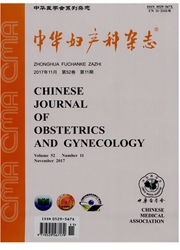

 中文摘要:
中文摘要:
目的 研究神经肽Y(NPY)及其受体NPY-Y1、Y2在盆腔器官脱垂(POP)患者主韧带和宫骶韧带上的分布、表达及意义。方法 选择POP患者16例,按盆腔器官脱垂定量(POP.Q)分度法分度,其中POP-Q分度法为I、Ⅱ度者6例为A组,Ⅲ、Ⅳ度者10例为B组。选择无POP的卵巢非功能性肿瘤患者8例作为对照组。标本取自主韧带、宫骶韧带,经甲醛固定、石蜡包埋后切片,采用免疫组化法检测NPY的分布;采用RT-PCR技术检测NPY-Y1和Y2mRNA的表达。结果 (1)NPY在主韧带、宫骶韧带上均有分布。与对照组比较,NPY在POP患者的主韧带和宫骶韧带上的分布有减少的趋势,但3组间比较,差异均无统计学意义(P〉0.05);NPY在各组患者自身主韧带和宫骶韧带上的分布情况比较,差异均无统计学意义(P〉0.05)。(2)NPY-Y1和Y2mRNA在主韧带、宫骶韧带中均有表达,并检测到NPY-Y1中97bp的剪切变异体存在。(3)NPY-Y1mRNA在主韧带上的表达,A组(3.9±1.0)与B组(6.0±1.5)之间,以及B组与对照组(3.4±0.9)之间比较,差异均有统计学意义(P=0.019,P=0.004);A组与对照组之间比较,差异无统计学意义(P:0.082)。NPY-Y1mRNA在宫骶韧带上的表达,A组(6.0±1.1)与B组(6.3±0.7)之间,以及A组与对照组(4.8±0.7)之间分别比较,差异均无统计学意义(P=0.151,P=0.690);B组与对照之间比较,差异有统计学意义(P=0.016)。(4)NPY.Y2mRNA在主韧带和宫骶韧带上的表达,A组(分别为0.56±0.21、0.67±0.13)、B组(分别为0.85±0.43、0.69±0.21)、对照组(分别为0.49±0.34、0.61±0.15)3组之间分别比较,差异均无统计学意义(P〉0.05)。(5)NPY-Y1、Y2mRNA在各组患者自身主韧带与宫骶韧带上的表达比较,差异均无统计学意义(P=0.084,P=0.470)。结论 NPY及其受
 英文摘要:
英文摘要:
Objective To evaluate the distribution of neuropeptide Y and its receptors in the cardinal ligament and uterosacral ligaments in women with and without pelvic organ prolapse (POP). Methods Sixteen patients with pelvic organ prolapse entered the study. All patients were evaluated by pelvic organ prolapse quantitation (POP-Q). Group A consisted of six patients with grade I , II POP, and group B comprised ten patients with grade Ⅲ, IV POP. Eight nonfunctional ovarian tumor patients without POP were recruited as control subjects. Biopsies of cardinal ligament and nterosacral ligament were obtained from each woman during surgery. Immunohistochemical study with polyclonal antibody against a general nerve marker S-100 and neuropeptide Y was performed on paraffin-embedded sections of all the samples. In addition, mRNA levels of the human NPY-Y1 and NPY-Y2 receptors were assessed in both patients and controls. Results (1)NPY immunoreactivities were identified in both cardinal ligament and uterosacral ligament. NPY immunoreactive nerve fibers were insignificantly lower in POP patients ( P 〉 0. 05 ). The distribution pattern of NPY was similar in cardinal ligament and uterosacral ligament ( P 〉 0. 05 ). ( 2 ) mRNAs encoding the NPY-Y1 and NPY-Y2 receptors were detected in the pelvic supporting tissues. Besides the expected NPY-Y1 PCR products, an additional 97 bp long amplicon originating from an alternative splicing event was found in most tissues studied. ( 3 ) In cardinal ligaments, mRNA encoding NPY-Y1 receptor had a significant difference between group A ( 3.9±1.0) and B ( 6. 0±1.5 ), and between control ( 3.4±0.9 ) and group B ( P = 0.019, P = 0. 004) , while there was no significant difference between group A and controls( P = 0. 082). In uterosacral ligaments, mRNA encoding NPY-Y1 receptor had no significant difference between Group A ( 6. 0±1.1 ) and B ( 6. 3±0. 7) , or between group A and controls (4. 8±0. 7 ; P = 0. 151, P = 0. 690) ; while t
 同期刊论文项目
同期刊论文项目
 同项目期刊论文
同项目期刊论文
 Neuropeptide Y expression in vaginal epithelium of women with pelvic organ prolapse and stress urina
Neuropeptide Y expression in vaginal epithelium of women with pelvic organ prolapse and stress urina 期刊信息
期刊信息
